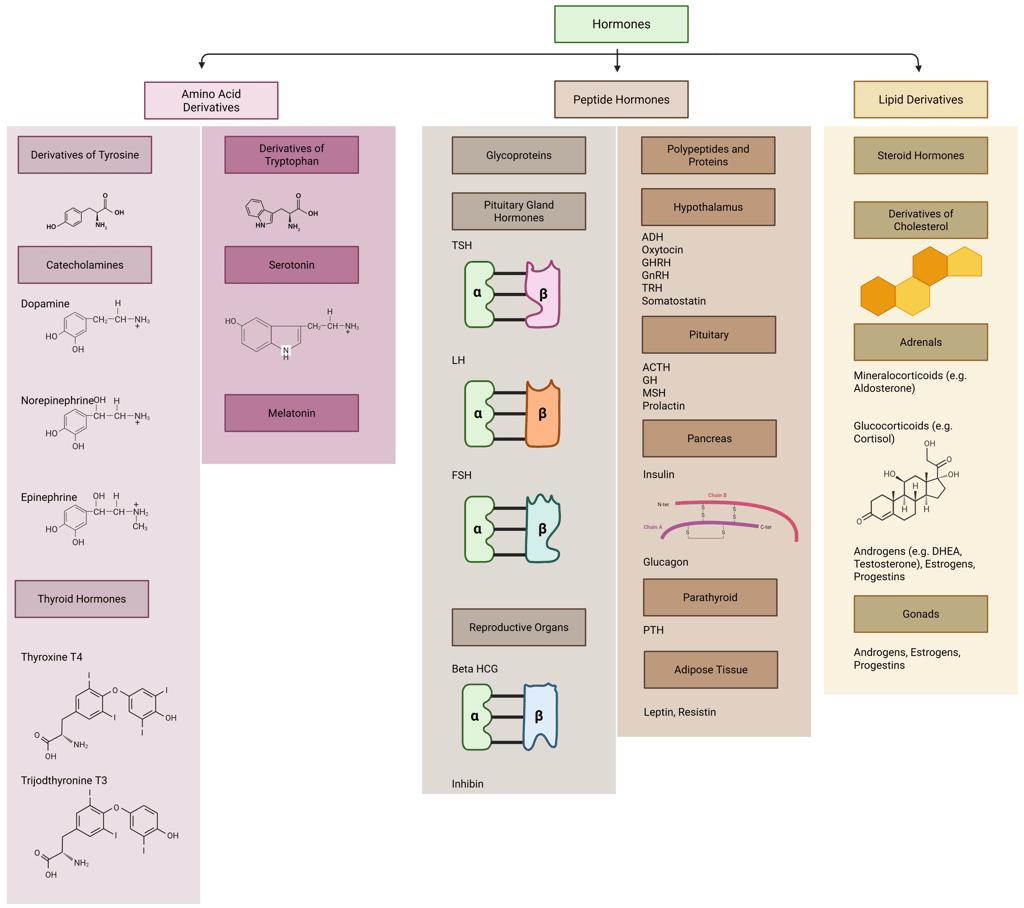Hormone Biochemistry and Distribution
Biochemical Structure of Hormones
Hormones are biochemical messengers that carry out endocrine functions by acting on specific target cells. As described earlier, hormones are synthesized by specialized cells and tissues using specific precursor molecules. The nature of these precursors forms the basis for classifying hormones into three main groups: amino acid derivatives, peptide hormones, and lipid derivatives. As we will discuss in this section, the molecular structure not only determines how hormones are synthesized but also influences how they are transported in the bloodstream, their stability/metabolization, receptor specificity, and the mechanisms of signal transduction they initiate.


Illustration: Biochemical Structure of the most important Hormones. Created in https://BioRender.com
Protein Binding and Distribution
After entering the circulation, certain hormones, such as growth hormone and insulin, are immediately biologically active, whereas others require conversion within target cells to achieve full activity. Protein hormones and small water-soluble molecules like catecholamines circulate freely in the plasma. In contrast, lipid-soluble hormones, including steroid and thyroid hormones, are poorly soluble in water and therefore depend on specific transport proteins for distribution. These hormones bind to plasma carrier glycoproteins such as thyroxine-binding globulin (TBG), sex hormone–binding globulin (SHBG), and corticosteroid-binding globulin (CBG), as well as to albumin. The hormone–protein complexes act as reservoirs, facilitate systemic transport, and protect the hormones from rapid degradation and excretion via the kidneys or bile. A dynamic equilibrium exists between the protein-bound and unbound (“free”) fractions of circulating hormone, with only the free portion capable of entering target cells to exert biological effects. Although certain binding proteins exhibit high affinity for their respective ligands, no single carrier protein is strictly indispensable for hormone distribution.
Hormone-binding globulins are primarily synthesized in the liver, although transthyretin (TTR) is also produced in the choroid plexus. As we will discuss in the section "hormone metabolization", the degree of protein binding plays a key role in determining hormone clearance, significantly impacting plasma half-life.
The synthesis of hormone-binding proteins is influenced by various physiological and pathological factors. As most are synthesized in the liver, proper hepatic function is essential for maintaining normal levels. Estrogen plays a regulatory role for several binding proteins. For instance, estrogen-containing contraceptives increase CBG concentrations, complicating the interpretation of cortisol levels in assays that do not differentiate between free and bound cortisol. Similarly, during pregnancy, elevated estrogen leads to increased TBG levels, which may affect thyroid function tests and can necessitate dosage adjustments in women receiving levothyroxine therapy.
Metabolic status also affects binding protein concentrations. SHBG levels are typically reduced in obesity, which can result in misleadingly low total testosterone levels without corresponding clinical signs of hypogonadism. SHBG is further modulated by thyroid function: it is elevated in hyperthyroidism, altering the testosterone-to-estrogen ratio and contributing to the development of gynecomastia in affected males.
In addition, changes in albumin levels can influence the interpretation of various endocrine laboratory tests, including those for calcium and thyroid hormones, due to its role as a non-specific hormone and ion carrier.
References
All Illustrations were created in https://BioRender.com
For References, visit the Section "References" in General Principles of Clinical Endocrinology
© 2025 EndoCases. All rights reserved.
This platform is intended for medical professionals, particularly endocrinology residents, and is provided for educational purposes only. It supports learning and clinical reasoning but is not a substitute for professional medical advice or patient care. The information is general in nature and should be applied with appropriate clinical judgment and in accordance with local guidelines.
All of the content is independent of my employer.
Use of this site implies acceptance of our Terms of Use
Contact us via E-Mail: contact@endo-cases.com